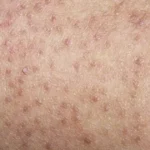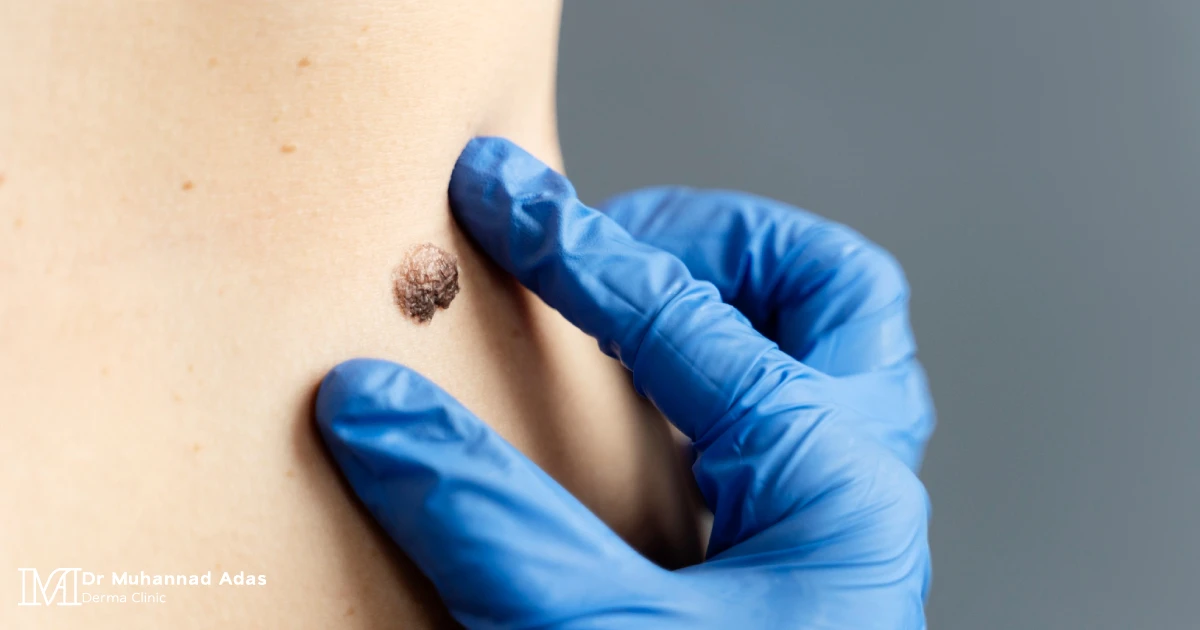Table of Contents
Moles have always been seen as a beauty mark for those who have them, especially when they are visible on the face or neck. Others often admire them, and some even wish to have them. Many women who do not have moles have resorted to drawing them with eyeliner or getting them done at clinics to shine and stand out. However, does everyone who has moles love them? Do they always form in an aesthetically pleasing way, or can they be bothersome to some? Are they considered a health condition in themselves, or can they be dangerous?
The appearance of moles is a natural condition that occurs in the majority of people, however, for some people they may appear in undesirable locations or in an irregular manner, leading to feelings of embarrassment or discomfort. Their condition can also change from time to time, causing some concerns for individuals, which are often unfounded and do not warrant panic.
We are here to answer many of your questions regarding their definition, the potential risks associated with them, and how to remove moles using laser, which is one of the latest techniques in the world of cosmetics.
What are Moles?
Moles, also known as beauty marks, are a type of skin growth that appears on various parts of the body, they form due to the accumulation of pigment-producing cells, known as melanocytes, resulting in relatively small dark brown spots that can be oval or round in shape. Moles are considered skin lesions but are generally harmless, they typically appear during childhood and adolescence, with individuals having about 10 to 45 moles by the time they reach adulthood. The number, shape, and size of moles can vary from one person to another, and their colors range from natural skin tone to pink, brown, or black. People with darker skin or hair often have moles that appear in darker shades.
Moles can be treated in just one session, depending on the type of device and the method used, unlike the removal of spots and pigmentation, which typically requires multiple sessions. This procedure is characterized by a quick recovery time as burn marks usually fade within about a week after the session, leaving only slight redness in the area, which gradually disappears over approximately 1 to 6 months.
It is possible that a mole may reform about a month after its removal, particularly if it was a melanocytic mole. In such cases, another laser session is performed to remove it again.
General Facts About Moles
To learn more about moles, here are some additional pieces of information:
- Moles can remain the same, fade, or disappear over time.
- They can appear either flat or raised.
- People with fair skin tend to have more moles due to their increased sensitivity to sunlight.
Factors Affecting the Appearance and Increase in the Number of Moles
The skin is affected by various factors that influence the pigment-producing cells and melanocytes, leading to the formation of moles. Some factors that increase the number of moles in individuals include:
- Prolonged exposure to sunlight can damage the DNA of skin cells, stimulating abnormal growth and resulting in the appearance of moles.
- Hormonal changes during puberty, pregnancy, or menopause.
- Use of birth control pills.
- Aging, as the incidence of moles can increase with age, particularly in elders.
- Genetic factors, as family history significantly influences the likelihood of developing moles or skin cancer.
Can Moles be Removed with Creams or Traditional Methods?
No. There has been recent talk about home remedies or creams online that claim to remove moles, however, it is not advisable to attempt this procedure, especially through traditional methods, without consulting a qualified doctor. The effectiveness of these methods in removing moles has not been proven, and creams may have little to no significant effect.
Most moles do not require treatment, as their appearance typically poses no risk in most cases. Some individuals may choose to cover them with cosmetic products or care for them, particularly if hair is present keeping the area clean. It is advisable to consult a dermatologist or specialist if the moles are bothersome or if they show any specific changes. However, moles can be removed either through laser treatment or surgically.
The specialist doctor will examine your condition and provide consultation based on scientific principles, ensuring that sterilization and cleanliness are maintained in their clinic, which may not be available at home or through ordinary individuals. Additionally, a sample of the mole can be sent to a laboratory for analysis to confirm its safety after the procedure.
When Should the Appearance of Moles Raise Concern?
The appearance of moles often does not warrant any fear or concern, contrary to popular belief. In fact, 99% of moles are considered normal and only a small percentage potentially develop into skin cancer, specifically melanoma (melanocytic skin cancer).
While the formation of moles itself is generally harmless, any changes in their condition could indicate a type of cancer or precancerous condition. Here are some factors that require you to consult a specialist or seek immediate evaluation:
How to Differentiate Between Cancerous and Normal Moles
If you notice any of the following changes in your moles, it is essential to visit a professional:
- Change in Color.
- Change in Skin Texture.
- Change in Size.
- Irregular borders surrounding the mole.
- Itching sensation at the site of the mole.
- Bleeding at the site of the mole.
- Other unusual symptoms that differ from the mole’s normal appearance.
Laser Mole Removal
Laser mole removal is considered one of the latest and best methods for removing moles, as well as being one of the safest techniques available. It is important to be cautious when choosing a clinic and cosmetic or dermatological doctor, because if the procedure is not performed safely, it can lead to serious complications.
The procedure involves directing laser beams directly onto the mole area, which breaks down and fragments the skin cells, leading to the mole’s disappearance. In many cases, the mole can be removed in the first session, but some cases may require more than one session to achieve the desired results. A laser mole removal session typically takes about 30 minutes to complete.
9 Reasons to Undergo Laser Mole Removal
Many people resort to laser mole removal for various reasons that distinguish it from other procedures. It has become a popular treatment recently, receiving numerous positive responses. Here are some reasons why laser mole removal stands out:
- Simple procedure that is straightforward and does not involve complex steps.
- Quick sessions where each session typically lasts about 30 minutes.
- The issue can often be resolved in just one session.
- Painless procedure.
- It is a very safe technique that does not cause serious complications.
- Side effects are usually mild and temporary, disappearing within a short period.
- The results are effective and guaranteed without the need for surgery or general anesthesia.
- Patients can return to their normal activities shortly after the session.
- The laser technique specifically targets the mole without affecting surrounding skin tissues or cells.
Pre Mole Removal
The process of laser mole removal is relatively easy but requires some preliminary steps to ensure that the procedure will be carried out correctly and effectively. These steps include:
- Consultation with a dermatologist or a trusted & qualified specialist.
- General skin and mole examination to determine its type and safety, including checking for any cancerous cells.
- The doctor may request certain tests or analyses.
- Inform the doctor about your medical history and any medications you are currently taking.
- Avoid smoking and alcohol before the procedure.
- Choosing the right removal method as the specialist will determine it. If there are concerns about the type of mole and its condition, laser removal may not be suitable, as it can be challenging to send it for laboratory analysis afterward. In such cases, surgical removal may be necessary, allowing for a sample to be taken for safety testing.
Mole Removal Steps
The dermatologist or specialist begins by examining the skin and moles to identify which moles will be removed and the area is cleaned after. An anesthetic is usually administered, either topically or via an injection at the surgical site, or both, to ensure that the patient does not feel any discomfort during the procedure. The process is quick & very straightforward and multiple moles can be removed in a single session.
The specialist may also take photographs of the mole or moles during this time for later comparison and to monitor improvement. Afterward, a laser beam is directed at the area of the mole or moles, breaking down the melanin pigment in the mole and vaporizing it. The healthcare professional then applies an antibiotic ointment to the treated area.
It is important to note that this procedure is simple and is considered an outpatient treatment, meaning that patients can return to their normal activities after the session is completed.
Laser Mole Removal Complications
There are very minor complications that may occur following laser mole removal, which can be easily managed if you follow the instructions of a dermatologist or specialist at the clinic. These include:
- A small wound at the site of the mole.
- Possible swelling and blisters in the treated area.
- Temporary pain or burning sensation which can be alleviated with ointments or ice packs.
- Numbness at the site of mole removal.
- Temporary Scarring.
- Mild redness in the area.
Important Instructions to Follow Post Laser Mole Removal
Here are some instructions that your doctor will provide which you should follow for better and more effective results:
- Avoid sun exposure, especially the area where the mole (or moles) was removed, and make sure to use a high-SPF sunscreen.
- Refrain from applying cosmetics or perfumes on the treated area.
- Consult your doctor if you are taking any medications after the session.
- Keep the mole removal site covered with a bandage for just one day.
- Apply any ointments prescribed by your doctor.
- Apply ice packs if necessary.
- Avoid smoking and drinking alcohol after the procedure.
- Avoid scratching the area where the mole was removed.
Cost of Laser Mole Removal
The cost of laser mole removal depends on several factors such as the number of moles to be removed, their location, the area they cover, and their size. The specialization and experience of your doctor also play a role in determining the cost.
We have clarified the most important information about moles, how to deal with them, and the differences between normal and cancerous moles. We have also delved deeper into the process of laser mole removal.
Contact our clinic to schedule an appointment for various surgical and non-surgical cosmetic procedures by calling the following number:
Make sure to stay updated on the latest developments in the world of cosmetics by visiting our website:



